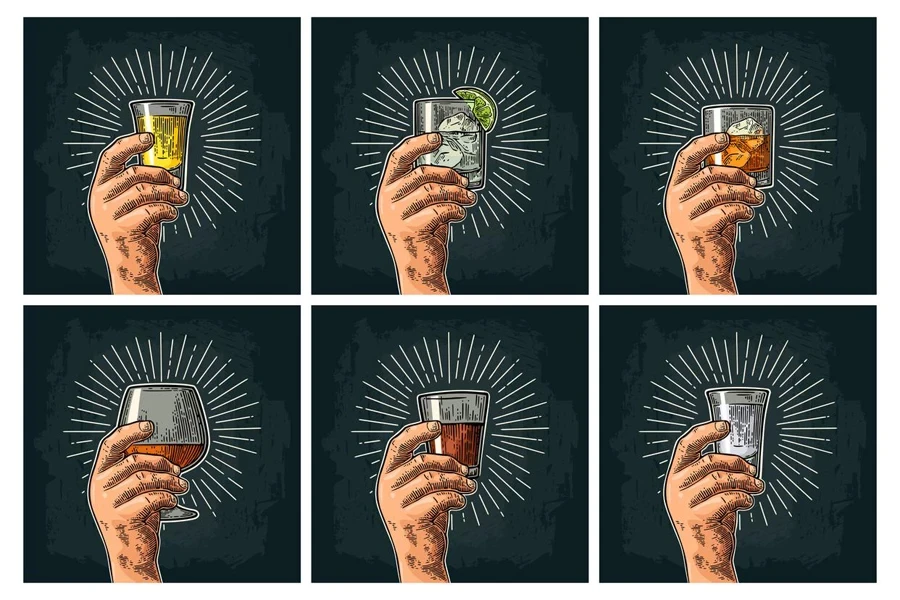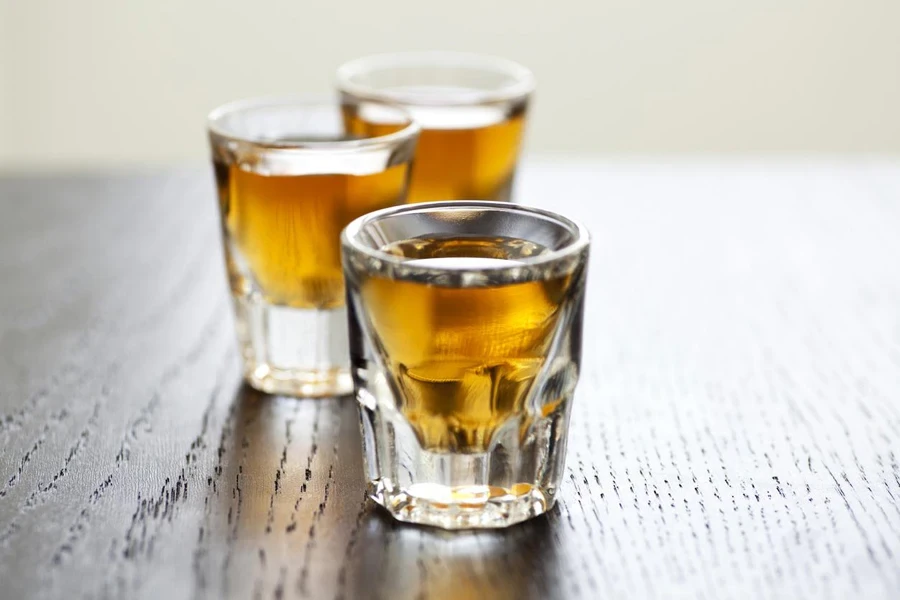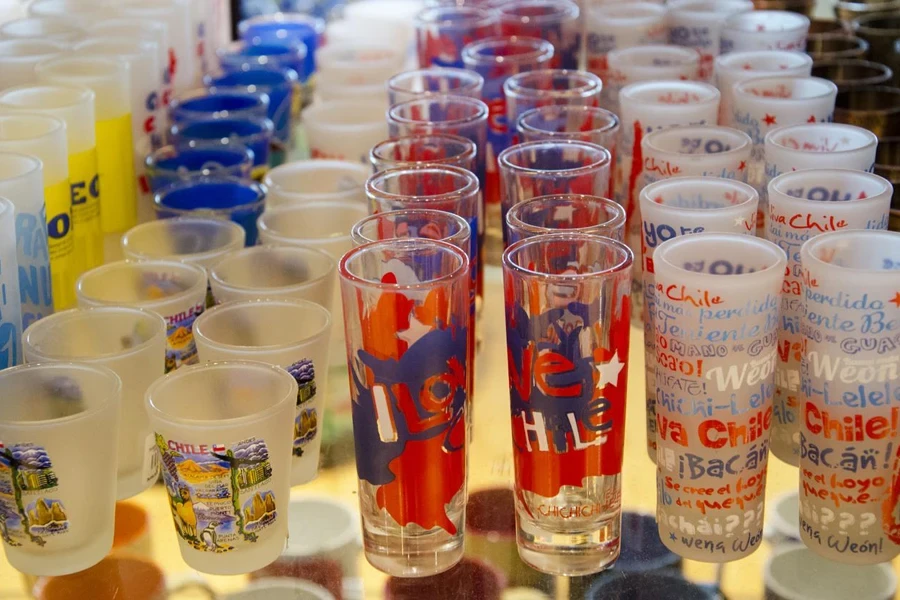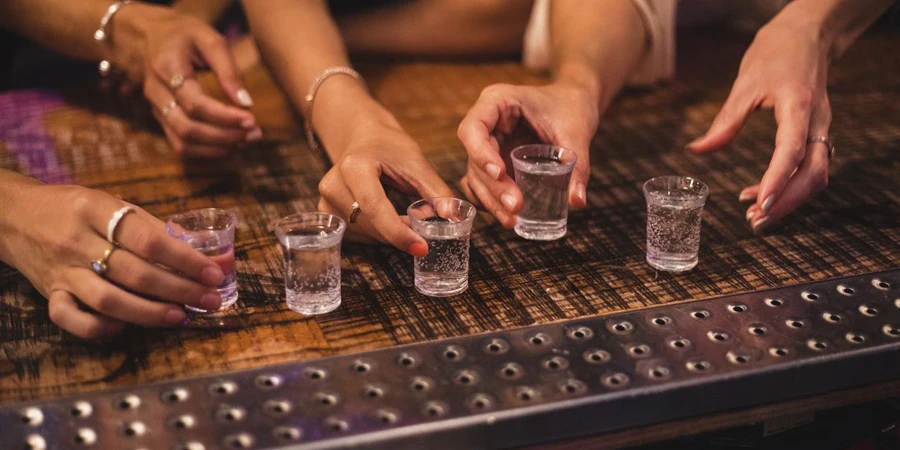Sourcing the perfect shot glass can significantly impact your business, whether you’re a wholesaler, retailer, or procurement professional. With the right knowledge and insights, you can make informed decisions that cater to your customers’ preferences and enhance your product offerings.
Table of Contents
● Understanding the Shot Glass Market Landscape
● Regional Markets to Watch
● Different Types of Shot Glasses and Their Features
● Things to Consider When Selecting Products
Understanding the Shot Glass Market Landscape
Reported by Grand View Research, the global glass-based drinkware market has seen steady growth over the past years with an average annual growth rate of 6.4%, driven by the increasing popularity of home bars and the rising trend of personalized gifts.
One of the most recognizable types of liquor glasses is the shot glass. The shot glass market is segmented into several categories, including material (glass, plastic, metal), design (plain, printed, custom), and capacity. Glass shot glasses hold the largest market share due to their durability and aesthetic appeal. Custom and printed shot glasses are also gaining traction, catering to niche markets and special events.
Regional Markets to Watch
North America: Embracing Personalization
North America remains the largest market for shot glasses, driven by the high number of bars, clubs, and restaurants. Consumers in the United States are increasingly seeking shot glasses that reflect their individual style and brand identity, particularly for events and promotional purposes. The region is also witnessing strategic moves by manufacturers to leverage the market growth, such as product line expansions and innovative designs.
Europe: A Hub for Premium Glassware
Europe follows closely, with a strong market presence in countries like Germany, the UK, and France. The region’s rich cultural heritage and tradition of celebrating with spirits, coupled with increasing consumer spending on premium glassware products, contribute to steady demand. Germany and the United Kingdom are the key markets within Europe, with a strong preference for high-quality, aesthetically pleasing shot glasses. Additionally, the growing trend of home entertaining and DIY bar setups has boosted sales of decorative and themed shot glasses.
Asia-Pacific
The Asia-Pacific region is witnessing rapid growth, particularly in countries like China, India, and Japan. The increasing middle-class population and rising disposable incomes are driving the demand for high-quality and stylish shot glasses. Furthermore, the region’s vibrant nightlife and expanding hospitality industry contribute to market growth.

Different Types of Shot Glasses and Their Features
The segmentation of shot glasses typically refers to the categorization based on their design, usage, and features. Here’s a breakdown of the various types of shot glasses:
Standard Shot Glass
The standard shot glass is the most common type, typically holding 1 to 1.5 fluid ounces of liquor. These glasses are versatile, affordable, and widely available, making them a popular choice for bars and events. Standard shot glasses can be made from various materials, including glass, plastic, and stainless steel, each offering unique benefits in terms of durability and aesthetics.
- Description: Traditional shot glass with a simple, cylindrical shape.
- Capacity: Typically holds 1 to 1.5 ounces of liquid.
- Usage: Used in bars, restaurants, and homes for serving standard shots of liquor.
- Materials: Commonly made of glass, but can also be found in plastic or metal.
- Market: Widely used and the most common type of shot glass, popular in both commercial and personal settings.
Tall Shot Glass
Tall shot glasses, also known as shooters, are taller and narrower than standard shot glasses. While they may appear to hold more liquor, they typically have the same capacity as standard shot glasses. Tall shot glasses are ideal for layered shots and creating visually appealing drinks.
- Description: Taller and often slimmer than standard shot glasses.
- Capacity: Usually holds more than 1.5 ounces, ranging from 2 to 3 ounces.
- Usage: Suitable for layered shots, cocktails, and larger servings of liquor.
- Materials: Mostly glass, but available in other materials as well.
- Market: Favored in bars and clubs for more visually appealing presentations and larger shots.
Cheater Shot Glass
Cheater shot glasses have a thicker, heavier base, giving the illusion of a full shot while actually holding less liquor. These glasses are perfect for those who want to enjoy the shot-taking experience without overindulging. Cheater shot glasses are also popular for serving smaller portions of high-end spirits.
- Description: Appears to hold a full shot but has thicker glass or a false bottom, reducing actual liquid capacity.
- Capacity: Holds less than the standard 1 to 1.5 ounces despite looking the same size.
- Usage: Used by some bars to reduce alcohol consumption while maintaining the appearance of a full shot.
- Materials: Usually made of glass.
- Market: Common in bars looking to manage costs and control alcohol portions.
Fluted Shot Glass
Fluted shot glasses feature a flared mouth and a fluted base, adding a touch of elegance to the traditional shot glass design. Originally created for consuming high-quality whiskey, fluted shot glasses are now used for a variety of spirits and liqueurs. Their unique shape enhances the aroma and flavor of the drink, making them a favorite among connoisseurs.
- Description: Features a fluted or ribbed design, often with a wider base and narrower top.
- Capacity: Typically holds 1 to 1.5 ounces.
- Usage: Adds a decorative element to the shot, used in more upscale or themed settings.
- Materials: Primarily glass.
- Market: Popular in specialty bars, themed restaurants, and for collectors.
Decorative and Designer Shot Glasses
Decorative and Designer Shot Glasses are the ultimate way to showcase your brand’s personality and style. These glasses come in a wide range of designs, colors, and materials, allowing you to create a truly unique drinking experience. From hand-painted artwork to custom logos and engravings, the possibilities are endless when it comes to personalizing your shot glasses.
- Description: Elaborately designed shot glasses, often featuring unique shapes, colors, and artwork.
- Capacity: Varies widely, but usually around 1 to 1.5 ounces.
- Usage: Used as collector items, gifts, or for special occasions and themed events.
- Materials: Can be made from glass, ceramic, metal, or even plastic.
- Market: Appeals to collectors, tourists, and for use in themed events and parties.

Things to Consider When Selecting Products
Material and Durability
The material of the shot glass is crucial in determining its durability and suitability for different occasions. Glass is ideal for indoor use and provides a premium feel, while plastic and metal are better suited for outdoor events and durability.
- Glass Shot Glasses
Glass shot glasses are the most popular type, known for their clarity and durability. They come in various designs, from classic plain glasses to intricate engraved patterns. They are ideal for both commercial use in bars and personal use at home.
- Plastic Shot Glasses
Plastic shot glasses are lightweight and versatile, making them perfect for outdoor events and parties. They are available in various colors and can be disposable or reusable. While not as durable as glass, they offer a cost-effective option for large gatherings.
- Metal Shot Glasses
Metal shot glasses, typically made from stainless steel, offer a unique and modern aesthetic. They are durable and often come with insulated properties, keeping drinks cooler for longer. These are popular for camping and outdoor activities due to their sturdiness.
Capacity
When selecting shot glasses, consider the standard serving size for your establishment or event. Most shot glasses hold between 1 and 2 fluid ounces, with 1.5 ounces being the most common. Ensure that your chosen shot glass can accommodate your desired serving size without overflowing or appearing underfilled.
Here are some statistics about the average shot glass size:
- The typical shot glass size in the United States is 1.5 fluid ounces. A half shot glass size in the U.S. is 0.75 fluid ounces.
- In the UK, a standard shot is approximately 25 milliliters.
- Dutch jenever shots are typically served in glasses of 35 milliliters.
- In Germany, a shot glass commonly measures 20 milliliters.
- An Australian standard shot is commonly 30 milliliters.
- In Russia, the “chalice” shot glass, used for vodka, can be up to 50 milliliters.
- In Poland, a shot glass for vodka is around 40 milliliters.
- In Germany, a shot glass commonly measures 20 milliliters.
- South Korean soju shot glass is typically 50 milliliters.
- Japanese “go” shot glasses are often 180 milliliters in size, significantly larger than typical shot glasses elsewhere.”

Design and Customization
Consider the design and customization options available. Personalized shot glasses can enhance brand recognition and add a special touch to events. Look for suppliers who offer a wide range of customization options to meet your specific needs.
Occasion and Target Audience
Tailor your shot glass selection to the occasion and your target audience. For weddings, opt for elegant and timeless designs that incorporate the couple’s initials or wedding date. Corporate events may call for sleek, professional designs that showcase your company’s logo and values. Understanding your audience’s preferences and the event’s theme will guide you in making the perfect choice.
Environmental Impact
With growing consumer awareness of environmental issues, consider sourcing shot glasses made from sustainable materials. Suppliers that prioritize eco-friendly practices will appeal to environmentally conscious customers and align with global sustainability trends.
Conclusion
Sourcing the right shot glass for your business involves understanding market trends, regional demands, and the various types of products available. By considering factors such as material, design, and supplier reliability, you can make informed decisions that cater to your customers’ needs and enhance your product offerings.




